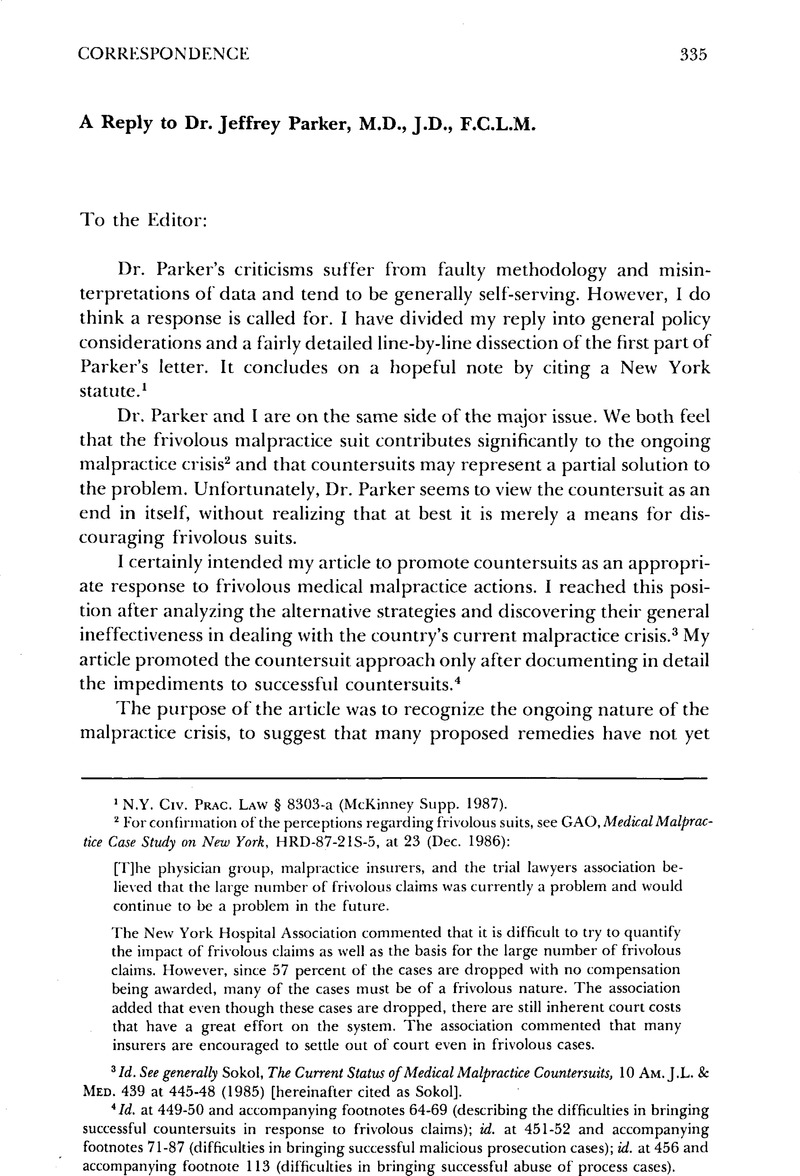No CrossRef data available.
Article contents
A Reply to Dr. Jeffrey Parker, M.D., J.D., F.C.L.M.
Published online by Cambridge University Press: 24 February 2021
Abstract

- Type
- Correspondence
- Information
- Copyright
- Copyright © American Society of Law, Medicine and Ethics and Boston University 1986
References
1 N.Y. Civ. Prac. Law § 8303-a (McKinney Supp. 1987).
2 For confirmation of the perceptions regarding frivolous suits, see GAO, Medical Malpractice Case Study on New York, HRD-87-21S-5, at 23 (Dec. 1986):
[T]he physician group, malpractice insurers, and the trial lawyers association believed that the large number of frivolous claims was currently a problem and would continue to be a problem in the future.
The New York Hospital Association commented that it is difficult to try to quantify the impact of frivolous claims as well as the basis for the large number of frivolous claims. However, since 57 percent of the cases are dropped with no compensation being awarded, many of the cases must be of a frivolous nature. The association added that even though these cases are dropped, there are still inherent court costs that have a great effort on the system. The association commented that many insurers are encouraged to settle out of court even in frivolous cases.
3 Id. See generally Sokol, The Current Status of Medical Malpractice Countersuits, 10 AM. J.L. & MED. 439 at 445-48 (1985) [hereinafter cited as Sokol].
4 Id. at 449-50 and accompanying footnotes 64-69 (describing the difficulties in bringing successful countersuits in response to frivolous claims); id. at 451-52 and accompanying footnotes 71-87 (difficulties in bringing successful malicious prosecution cases); id. at 456 and accompanying footnote 113 (difficulties in bringing successful abuse of process cases)
5 See Parker, , The Failure of the Medical Malpractice Countersuit Movement—A Reply to Sokol, 12 Am. J.L. Med. 323 (1986)Google Scholar [hereinafter Parker]. Please note that in an earlier draft of this reply, in a notably self-serving manner, Parker seems to imply that the approach to accomplish this is by writing letters to the editors of medical journals, despite the fact “for years [his] exhortations have fallen upon deaf ears,” and that he “was baffled by [the] thinly-disguised cop-out, and downright dismayed when [he] encountered the same languid cynicism and lame excuses from organized medicine at the state and local levels.” I can only conclude from these statements that his suggested approach thus far does not seem to have borne fruit.
6 Id. at 7.
7 Id. at 7 n.7.
8 Id. at 7.
9 Supra note 5, at 7.
10 Note, Malkious Prosecution Liability of Plaintiff's Counsel for an Unwarranted Medkal Malpractice Suit—New Developments in Physician Countersuits for Unfounded Medical Malpractice Claims, 7 N. KY. L. REV. 265 (1980)Google Scholar [hereinafter cited as Note].
11 Id. at 266.
12 Id. at 280.
13 Id.
14 Id. at 281.
15 175 Cal. Rptr. 374 (1981), Kg denied (Sept. 16, 1981).
16 233 Kan. 122, 660 P.2d 1361 (1983).
17 630 S.W.2d 68 (Ky. 1982).
18 81 111. 2d 201, 407 N.E.2d 47 (1980).
19 3 Wash. App. 139, 473 P.2d 202 (1970).
20 Sokol, supra note 2, at 449 n.62.
21 561 S.W.2d 331 (Ky. Ct. App. 1978).
22 175 Cal. Rptr. at 374.
23 630S.W.2dat68.
24 Note, supra note 8, at 268 n.20.
25 Sokol, supra note 2, at 449 n.61.
26 379 So. 2d 412 (Fla. Dist. Ct. App. 1980).
27 467 So. 2d 65 (La. Ct. App. 1985), reh'g denied (Apr. 23, 1985), writ denied (June 17, 1985).
28 379 So. 2d at 412.
29 See Dentist Wins Liability Countersuit, Am. Med. News, Apr. 20, 1979, at 3, col. 2.
30 No. A014929 (Cal. Ct. App. 1985) (opinion denied official publication by order of the California Supreme Court, October 23, 1985) (case was settled).
31 No. 78141 (Santa Cruz County Super. Ct., Cal. Aug. 21, 1986).
32 Parker, supra note 5, at 327-34.
33 If one were to follow Dr. Parker's strategy, which I gather is not to bring any countersuits as they are essentially ineffective, both the courts and the legislatures would remain unaware of the problem of frivolous malpractice actions. Thus, there would be no incentive to attempt to remedy the problem. It certainly appears to be more strategic to challenge the problem on all fronts. I do not believe that malpractice countersuits have even been attempted in many jurisdictions. Perhaps if they were, a trend would develop to help deter the frivolous suit.
34 N.Y. Civ. Prac. Law § 8303-a (McKinney Supp. 1987).
35 The action must be filed in bad faith soley to delay or prolong the resolution of litigation or to harass or maliciously injure another, or must be in bad faith without any reasonable basis in law or fact. If the action was promptly discontinued when the party or attorney learned or should have learned that the action did not have a reasonable basis, the court will find no bad faith. Broadened and amended in 1986, the statute now provides for costs upon frivolous claims and counterclaims in personal injury, injury to property or wrongful death actions. Id.




